Abstract
The objective of this study is to define groundwater management zones for a complex deformed and fissured Precambrian karst aquifer, which underlies one of the most important agricultural areas in the semi-arid region of Irecê, Bahia, Brazil. It is an unconfined aquifer, hundreds of meters thick, resulting from a large sequence of carbonates piled up by thrust faults during tectonic plate collisions. Groundwater recharge and flow in this aquifer are greatly influenced by karst features, through the high density of sinkholes and vertical wells. Over the past four decades, population and agricultural activities have increased in the region, resulting in unsustainable groundwater withdrawal and, at the same time, water quality degradation. Therefore, it is important to develop legal and environmental management strategies. This work proposes the division of the karst area into three well-defined management zones by mapping karst structures, land use, and urban occupation, as well as the concentrations of chloride and nitrate in the region’s groundwater. Zone 1 in the north possesses the lowest levels of karstification, anthropization, and contamination, while zone 2 in the central region has the highest levels and zone 3 in the south ranging in-between (except for stronger karstification). The delimitation of management zones will contribute to the development and implementation of optimized zone-specific groundwater preservation and restoration strategies.
1. Introduction
Karst aquifers provide important sources of drinking water, covering almost 25% of the world’s total. In the United States, 40% of water used is groundwater, and approximately 75% in the European Union [1,2,3]. With this high percentage, residents of the European Union depend almost exclusively on groundwater for their water supply [4]. In South America, karst regions constitute about 2% of the Earth’s surface, reaching 5–7% in Brazil [5]. In Bahia, karst aquifers are present in approximately 14% of the state’s area [6], part of which is in a semi-arid region dependent on groundwater. Karst aquifers often exhibit complex groundwater flow patterns that result from depositional heterogeneities and post-lithification fracturing and karstification [7]. They most commonly form in soluble rocks such as dolomite and limestone, and the process of dissolution and fracturing creates complex networks of preferred flow paths that are difficult to locate, making the development of flow models more challenging [8,9]. The heterogeneity of karst aquifers makes them difficult to explore through well drilling, as they are often unproductive, if fractures or water-bearing conduits cannot be found [10].
These karst aquifers are typically characterized by the existence of surface landforms such as vertical conduits, poljies, and sinkholes, and their subsurface features include conduits and voids that may develop into caverns and extensive integrated groundwater systems [11,12]. Historically, karst springs have been used to capture freshwater [10]. However, they experience large fluctuations in both discharge and water quality [13,14].
Karst regions also represent landscapes of cultural and touristic importance. In some regions, they present high species richness and endemism in plants and animals and are considered priority areas for biodiversity conservation [15]. In semi-arid regions, climate change, population growth, desertification caused by deforestation, mining for cement production, the expansion of irrigated agriculture, and complex economic activities in the karst landscape increase the pressure on water resources, compromising water availability in aquifers, surface runoff, and ecosystem quality [16].
These problems in the use of groundwater in fissured karst aquifers can be found in many other countries, such as China [17,18], Croatia [19], Greece [20], Italy [21], Romania [22], and Syria [23]. Furthermore, water quality in karst aquifers is generally considered particularly vulnerable to contamination due to the low capacity of karst aquifers to filter or attenuate contaminants [2,24]. Typical sources of contaminants in developing regions include domestic wastewater discharged into septic tanks or surface drainage, waste disposed of in unlined municipal landfills, fertilizers, and other discharges from agricultural activities [2,24].
The fissured limestone aquifer of the Irecê region is one of the most important agricultural areas in the semi-arid region of Bahia (Figure 1a,d) and is therefore the most important water source in the region. More than 5500 water wells for agricultural, domestic, and industrial use have been mapped, with a density of ~0.6 wells/km2 [25]. Its striking karst features also represent one of the main tourist attractions of Chapada Diamantina, home to sites with a high intensity of caving tourism visits.
The last four decades have seen an acceleration in both population growth and agricultural activities in the Irecê region. The combination of productive agricultural land, scarcity of surface water, abundant reserves of excellent groundwater, low government regulation in the enforcement of environmental laws, and low-cost flood irrigation explain the increase in the number of wells drilled for groundwater exploration and the amount of irrigated area in the region. This has affected the water levels in the aquifer, which are falling rapidly. The lowering of the potentiometric surface, in turn, affects the base flow to springs and rivers. On the other hand, the potential for groundwater contamination by agricultural activities and poor domestic waste disposal practices is a growing concern [26].
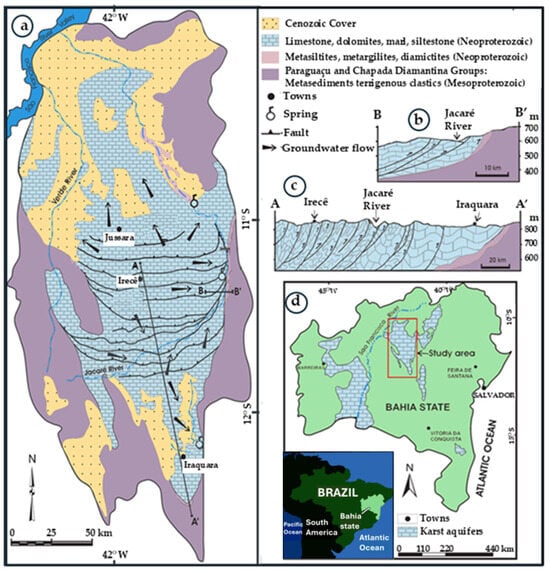
Figure 1.
Study area. (a) Geological map of the hydrogeological basin of the Irecê karst aquifer, showing the Chapada Diamantina Group, the karst aquifer, and Cenozoic Cover. (b) Cross-section in the central eastern portion of the Irecê karst aquifer, showing geological structures, with faults and folded strata. (c) Longitudinal section from the center to the south of the Irecê karst aquifer, showing geological structures, with faults and folded strata. (d) Situation and location of the Irecê karst aquifer. Source: Modified from [27].
It is therefore important that developing regions use environmental policies and management strategies to protect groundwater resources in karst aquifers. Furthermore, environmental protection in karst regions is necessary to sustain speleological tourism, which is of great economic importance.
The aim of this study is to better define water availability in the semi-arid karst region of Irecê and, through descriptions of the geological structure of the karst in this region, urban occupation, and groundwater quality, to assess the need for aquifer protection, suggesting groundwater management zones for a future tailoring of management strategies necessary for this rapidly developing area.
2. Materials and Methods
2.1. Karst Features
The Advanced Land Observing Satellite (ALOS) was launched on 24 January 2006 by the Japan Aerospace and Exploration Agency (JAXA) and was operational until 12 May 2011. The high-resolution (HR) L-band from the ALOS PALSAR (Phase Array type L-band Synthetic Aperture Radar) RTC (Radiometric Terrain Correction) 12.5 m DEM (Digital Elevation Model) was used to detect karst depressions. The automatic detection of karst features was performed through sink depth, which was derived from the depression-filling algorithm [28]. The process of detecting karst features followed four steps (Figure 2).
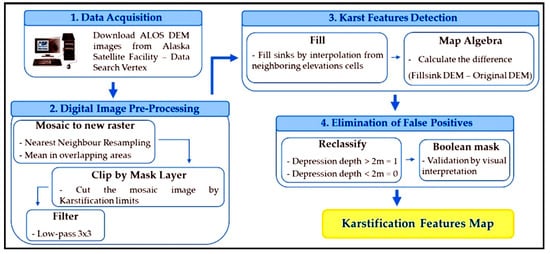
Figure 2.
Workflow of the digital image-processing sequence for karstification feature mapping (steps shown in execution order) [29].
The first step was the acquisition of DEMs through the Alaska Satellite Facility portal. A total of 17 images were acquired, eight images for sector 1, seven images for sector 2, and two images for sector 3. The second step was pre-processing the images. For each sector, one new image mosaic was generated in a single raster file. Then, the mosaic of each sector was cut by the karst limits, and finally, a low-pass filter was applied to eliminate spurious pixels. The third step was karst feature detection, which consisted of filling the closed depressions or sinks in the DEMs by interpolation from neighboring elevations, followed by automatic detection through map algebra, where the difference between the filled image (Fillsink DEM) and the original pre-processed DEM (Original DEM) was calculated. The final step was the elimination of false positive detections by reclassifying the sink depth image (which highlights various depressions, including karst-enclosed depressions) where areas with a depth greater than 2 m were assigned a value of one and all other areas were assigned a value of zero [29]. This process generated a Boolean mask image, which was validated using morphometric attributes and visual interpretation by overlaying the depression vectors on the high-resolution remotely sensed imagery (Figure 3) [30,31]. The final output was a karst feature map, highlighting dolines and other characteristic karst features, including valleys.
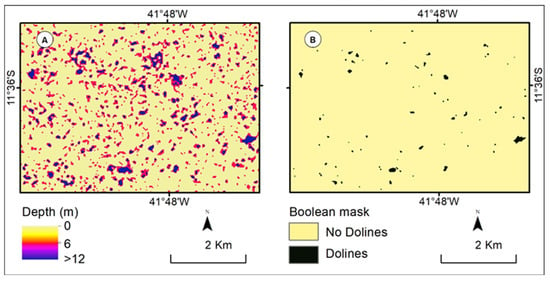
Figure 3.
Image processing for mapping karst features. (A) Sink depth image generated from ALOS DEM HR data, highlighting enclosed terrain depressions. (B) Map of karst features derived from the Boolean mask of (A), representing depressions exceeding 2 m in depth.
2.2. Land Use and Land Cover
The analysis of land use and land cover (LULC) was carried out with data from the LULC map collections from MapBiomas Brazil in GeoTiff format. The open access of the Landsat archive [30], in combination with the new cloud computing Google Earth Engine (GEE) platform with machine learning algorithms [31], allowed for reconstructing the LULC classification with a spatial resolution of 30 m for the year 2022. Table 1 describes each LULC class, with further details in [32].

Table 1.
Land use and land cover classes.
2.3. Contamination
Chloride and nitrate data were obtained from a public database [33] containing 912 tubular wells drilled in the karst aquifer with analyses between 1972 and 2019. Due to the strong asymmetry presented by the statistical distributions of the nitrate and chloride datasets, decimal logarithms of concentrations were used. The spatial interpolation of chloride and nitrate contents was initially carried out in electronic spreadsheets, and advanced topics were covered using the R language. In R, spatial data was manipulated through the sf [34] and sp [35] libraries. Finally, the spatialized variables were interpolated (through inverse distance weighting, IDW) using the gstat package [36], where vector products were obtained in sp format and exported as matrices in raster format. For this last step, the raster package was used [37].
IDW is a deterministic approach that estimates values at unsampled locations as a weighted average of nearby observations, with weights inversely proportional to the distance raised to a power (idp). To identify the optimal exponent, a leave-one-out cross-validation procedure was applied to each dataset. The idp parameter was tested across a range of values from 0.5 to 5.0, in increments of 0.5. The lowest root mean square error (RMSE) was obtained with idp = 1, which was therefore adopted for all interpolations.
2.4. Zonification
Maps of karstification intensity, land use/cover, as well as chloride and nitrate concentrations are used to identify three distinct and geographically contiguous regions based on classifications of low, medium, and high levels of karstification, anthropization (including urbanization), and contamination (Figure 4, Step 1). To facilitate effective water management in practice, these regions are further refined by delimiting them along municipal boundaries (Step 2), leading to a definition of three management zones 1, 2, and 3 with different hydrogeological and socioenvironmental characteristics.
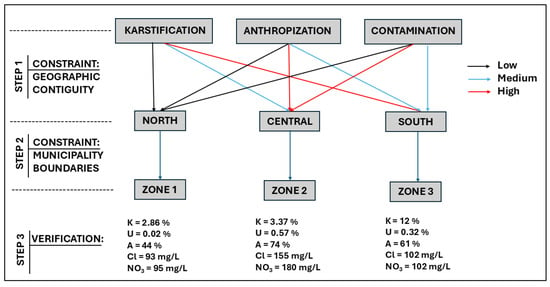
Figure 4.
Graphical representation of the methodology applied to define management zones 1, 2, and 3 (Steps 1 and 2), with resulting characteristics for verification (Step 3). Based on spatial information on karstification, land use (anthropization including urbanization) and groundwater contamination (mean well concentrations of Cl and NO3) in three geographically contiguous regions are identified and defined as separate management zones delimited by municipality boundaries. Variables K, U, and A are the spatial proportions occupied by karst features and urbanized and anthropized areas, respectively.
3. Results and Discussion
3.1. Geographic, Climatic, and Geological Setting
The Irecê fissured karst aquifer, with an area of approximately 19,500 km2, is extensively unconfined. The Precambrian carbonate rocks do not have confining units and are exposed at the ground surface. The carbonate formations are structurally complex and locally stacked by thrust faults, with an average thickness of 900 m. The extent of possible internal confining layers within the carbonate rock system is unknown [25].
The aquifer is located in a basin with both topographic and structural control. The elevation of the land surface throughout the basin varies from 600 m in the north, where the karst basin is bounded by the São Francisco River valley, to 1500 m in the low mountains to the south (Figure 1a). The topographic control of the basin may be related to karst weathering over millions of years [25]. The average annual precipitation in this semi-arid region is ~600 mm/year, with higher precipitation (~1000 mm/year) in its southern part. The dry season occurs between May and September. The average annual temperature is 25 °C, ranging from 18 °C to 38 °C. Potential evapotranspiration is approximately 2060 mm/year. Recharge calculated from a hydrometeorological water balance is about 55 to 65 mm/year, equivalent to approximately 10% of precipitation, with most infiltration occurring during the rainy season from November to March [38,39]. Groundwater recharge is from several sources, including (i) downward percolation from the limestone surface across the karst plain, (ii) cross-formational flow from underlying Mesoproterozoic silicate rocks exposed in low mountains surrounding the karst basins, and (iii) upward cross-formational flow from beneath the karst plain. The Jacaré and Verde are the major rivers, and their tributaries cross the karst plain and receive much of the natural discharge (Figure 1a) [25,27].
The karst aquifer consists of a sequence of Precambrian (Neoproterozoic) limestone and dolomite layers with intercalations of marl and siltstone. This sequence covers slightly metamorphosed Precambrian (Mesoproterozoic) terrigenous clastic rocks that comprise the Chapada Diamantina Group. Mesoproterozoic metasediments are exposed in the low mountains surrounding the karst basin. In the northern and southern parts of the study area, the carbonate sequence is partially covered by a layer of Cenozoic colluvial and/or eluvial plain and valley deposits of the São Francisco, Verde, and Jacaré rivers. The greatest carbonate thickness (>900 m) is in the central region near the municipalities of Irecê and Jussara [39,40] (Figure 1a).
The Irecê fissured karst area has a complex deformation history, with faults, folds, fractures, and thrust strata related to Neoproterozoic compressive tectonic events [40,41]. The compressive stress was oriented N-S, associated with the evolution of the mobile belt on the margin of the São Francisco Craton. The predominant direction of the faults is E-W (Figure 1b,c). The karst landforms in the study area are influenced by the structural geometry of faults, folds, and fractures and also have a predominant E-W orientation. Both paleokarst (inactive karst) and neokarst (active karst) features can be recognized. The Irecê fissured karst aquifer can be divided into three main structural domains (Figure 5).
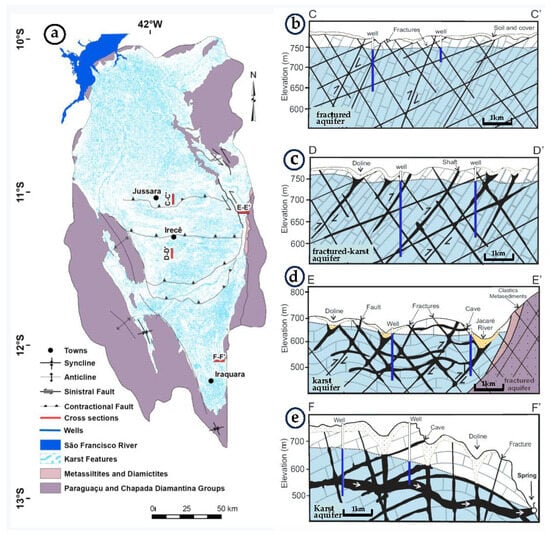
Figure 5.
Karstification. (a) Total karst features of the study area. (b) Longitudinal section showing the fractured karst aquifer in the central portion of the study area. (c) Longitudinal section showing the fractured karst aquifer in the south–central portion of the study area. (d) Cross-section showing the karst aquifer in the central eastern portion of the study area. (e) Cross-section showing the karst aquifer in the southeastern portion of the study area. Source: Modified from [27,40,42].
- The largest structural domain includes the northern and central part of the basin and is characterized by (a) subvertical beds and isoclinal folds with E-W axes, and (b) fractures with N40°/50°E and N40°/50°W directions (Figure 5b,c). The northern part has few documented karst features, such as springs, caves, and sinkholes, and is assumed to behave more like a fractured aquifer than a typical karst aquifer, although this may change with further mapping and study (Figure 5b). The central part of the aquifer has active karstification in the juvenile stage with a high density of narrow (5–10 m wide), elongated, E–W-oriented sinkholes and vertical sinkholes. Vertical sinkholes and elongated sinkholes concentrate aquifer recharge. They pose a serious geographic hazard to agricultural work and urbanization, while also putting the aquifer at risk of contamination.
- The second structural domain is located at the contact between Neoproterozoic carbonates and the older clastic metasediments of the Chapada Diamantina Group, around the edge of the karst basin. The carbonates overlie the metasediments in discordant contact and present a subhorizontal dip. The carbonates are cut by faults and fractures with N30°–40°W trends (Figure 5d). In this domain, karstification was formed by interformational groundwater flow from the underlying metasediments. Sinkholes and vertical depressions generally follow structural trends in this domain.
- The third structural domain to the south presents large folds, subhorizontal beds, long fractures with a predominant direction oriented N–S, and secondary fractures with directions of ~N15°W and N15°E (Figure 5e). Karstification is more developed in this area than in other parts of the aquifer. There is a high density of sinkholes of 100 m to 200 m in diameter, which typically follow N–S lineaments.
Several paleokarst caves and tunnels are exposed above the water table in the second and third structural domains and are attractive for speleological tourism. The karst system in the southern region extends to a considerable depth, below the regional hydrological base level defined by the São Francisco River valley. Groundwater flow occurs through a developed network of submerged conduits and caves to spring discharge points in the central and southern areas. The flow is predominantly turbulent [42,43]. It seems likely that karst features extend northwards into the São Francisco River valley, but as stated previously, there is little surface expression of major karst features throughout the northern structural domain.
3.2. Hydrogeological and Hydrochemical Conditions
Large rivers and their tributaries flow through the Irecê karst plain, although they are not completely perennial, and receive a large part of their flow as groundwater discharge. The location of the springs is controlled by the topography and the presence of faults. Drainage occurs to the north, where the karst basin is bounded by the São Francisco River valley. The potentiometric gradient, mapped from water levels measured in 300 wells, is about 0.001 to 0.002; such a low gradient is typical of confined non-karst aquifers, but also of highly permeable unconfined karst aquifers [39,42]. In the extreme south of the study area, local flow is southeastward towards the Paraguaçu River; here, the potentiometric gradient is steeper, around ~0.01 (Figure 5e).
The Irecê fissured karst aquifer has both autogenic and allogenic recharges. Autogenic recharge is derived exclusively from precipitation falling directly on karst outcrops [27,38,39]. Allogenic recharge is derived from flow underlying non-karst rocks or from surface water runoff from rivers and streams. Both the chemical composition of the water and the recharge volume per unit area tend to differ between autogenic recharge and allogenic recharge.
These differences can have considerable consequences for the size and distribution of karst features and the evolution of hydraulic conductivity. Autogenic recharge is predominantly found only in the northern and central regions of the aquifer. Recharge and groundwater flow in the northern area of less intense karstification may be more diffuse than those through controlled conduits. Flow is directed to the São Francisco River, possibly at low discharge velocities. Recharge in the central region is governed by the high density of vertical sinkholes. In its southern domain and around the perimeter of the karst aquifer, recharge is allogenic in character and comes from lateral flow of the underlying Mesoproterozoic metasediments. Deeper in the karst plain, upward flow of Mesoproterozoic metasediments may also occur.
Well productivity in the Irecê fissured karst aquifer ranges from 1 to 120 m3/h; about half of the wells pump at rates <7 m3/h. The water depth below the ground surface in more than 50% of the wells is <15 m; greater depths (40 to 70 m) occur in the southern part of the aquifer, where karstification is more developed [42]. Water levels are falling as withdrawal far exceeds recharge. Almost 20% (~1100) of the wells inventoried to date are at depths above the water table and dry. The transmissivity in the Irecê fissured karst aquifer, measured in 30 pumping tests, ranges from 5 to 20 m2/day. The average porosity, estimated from well logs in the upper 80 m of the aquifer, is 0.032 [44,45].
Groundwater analyzed in 912 wells in the Irecê karst region is classified as CaHCO3 and Ca-Cl hydrochemical type, with the following ionic sequences: HCO3 > Cl > SO4 and Cl > HCO3 > SO4. In all cases, the average concentration of Ca2+ plus Mg2+ exceeds that of Na+ plus K+. This pattern reflects the predominance of calcite and dolomite in the aquifer. The Mg/Ca ratio ranges from 0.3 to 0.8 in Ca-HCO3 waters and 0.1 to 0.4 in Ca-Cl waters. Waters with a low Mg/Ca ratio, together with other evidence, indicate that the time in contact with the rocks is too short to allow chemical equilibrium [38,46,47].
High concentrations of Cl and NO3 reflect impacts on groundwater quality in the Irecê karst region. Chloride concentrations range from 0.01 to 1788 mg/L as Cl (Table 2). The Cl content is >250 mg/L in about half of the region (Figure 6A). The Cl concentration is especially high in the central part of the aquifer (Table 2, Figure 6A), which may be due to the intense agricultural activities in that region. Nitrate concentrations range from 0.01 to 4800 mg/L as NO3 (Table 2). High NO3 concentrations tend to be found in the north–central part of the aquifer (Table 2, Figure 6B), where agricultural activities, including the use of fertilizers, are intense.

Table 2.
Descriptive statistical summary of chloride and nitrate concentrations in mg/L from 912 wells analyzed between 1972 and 2019 in the Irecê karst aquifer.
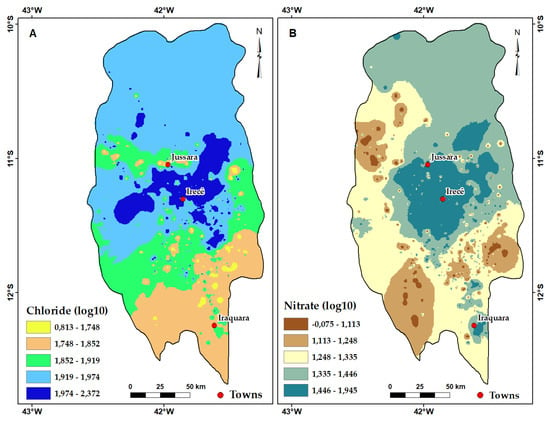
Figure 6.
Spatial mapping of well concentrations (decimal logarithms). (A) Chloride and (B) nitrate based on data from 912 wells analyzed between 1972 and 2019.
Other sources of contamination by Cl and NO3 loads entering the aquifer include domestic effluents and inadequate municipal waste disposal practices. Urbanization, especially in the southern and central sectors of the Irecê fissured karst aquifer, increases the need to develop rules and management programs to protect the quality of the aquifer from potential contamination in municipal waste (landfills), domestic effluents, and septic tanks.
The cumulative distribution functions (cdf’s) of chloride and nitrate in Figure 7a,b, respectively, demonstrate that there is a significant risk of encountering a contaminated well with concentrations above the maximum reference limits (MRLs) of 250 mg/L for Cl and 10 mg/L for NO3. This risk persists in all types of land use, and in total, for all wells analyzed, it amounts to approximately 20% for Cl and 65% for NO3 (black lines). In urban regions, there is a heavier lower distribution tail for Cl with a secondary mode (higher frequency of occurrence; blue line) near 10 mg/L, while the upper tail in irrigated agricultural areas is slightly weaker with a smaller risk of limit exceedance (brown line). For NO3, there is a relatively clear distinction of urbanization (blue line) and irrigated agriculture (brown line), with generally larger concentrations and exceedance risks of approximately 75% and 85%, respectively, with respect to the MRL.
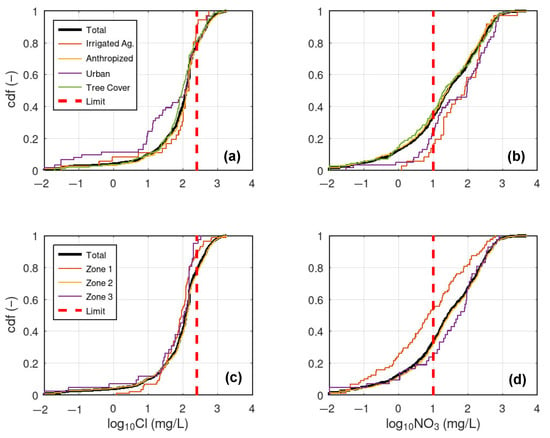
Figure 7.
Cumulative distribution functions (cdf’s) of decimal logarithms of chloride and nitrate concentrations in wells. (a,b) Subdivision by land use and land cover, and (c,d) subdivision by management zones. Maximum reference limits (MRLs) for chloride (250 mg/L) and nitrate (10 mg/L) are according to current Brazilian legislation.
3.3. Land Use, Management Zones, and Strategies
Based on the approach illustrated in Figure 4, three groundwater management zones are defined (Figure 8) considering the hydrogeological characteristics (Figure 5), the variations in water chemistry (Figure 6), and the differences in land use in the Irecê basin (Figure 8B):
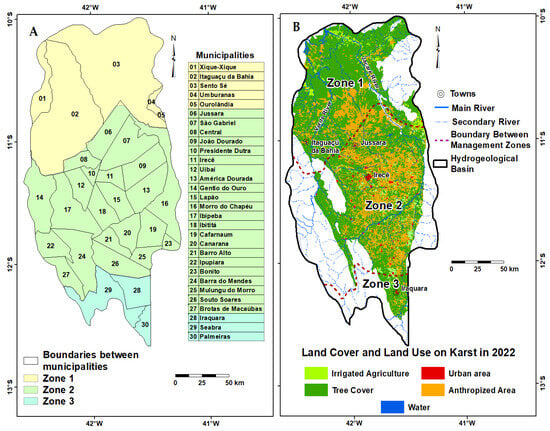
Figure 8.
Resulting management zones. (A) Municipalities representing the management zones 1, 2, and 3 of the region comprising the Irecê karst aquifer. (B) Land cover and land use in the Irecê karst aquifer in 2022 with proposed management zones 1, 2, and 3.
- Management zone 1 is located in the northern part of the basin, where the fissured karst aquifer is overlain by Cenozoic colluvial and river valley deposits. The aquifer shows less evident karstification in this area than in others. This zone currently has a lower population density, low agricultural activity (Table 3), and less groundwater exploitation than the other zones. Due to these factors, it appears to have less potential for contamination of groundwater resources than the other zones. Future urbanization and other developments, however, will require additional safeguards, including management strategies to minimize environmental degradation. Figure 6 shows a region in the west of management zone 1 with high concentrations for chloride, but low ones for nitrate. This can be explained by the fact that this is a small agricultural area on the banks of the Rio Verde, where the use of chloride-based agricultural inputs probably occurs more frequently. Among the most common substances are potassium chloride, widely used as fertilizer, ammonium chloride, as well as pesticides and herbicides containing chlorinated compounds, which are still used in the region. In general, the highest nitrate concentrations are associated with urban areas and, because there is low urbanization in this area, this is reflected in the low nitrate concentrations.
 Table 3. Percentages of land use categories in each proposed management zone in 2022.
Table 3. Percentages of land use categories in each proposed management zone in 2022. - Management zone 2 is in the central part of the aquifer, where karstification is well developed, the soils are thin, and the potentiometric surface is flat. In this zone, however, urbanization has been accelerating, increasing the development of irrigated agriculture and intensive use of groundwater. Although development and growth have brought great social and economic benefits, there have also been problems with unsustainable reductions in available water resources and increases in Cl and NO3 concentrations.
- Management zone 3 is located in the extreme south of the Irecê basin and presents karstification in a mature stage. The conduits are well developed, and the groundwater discharge to the springs is turbulent. The potentiometric surface is at a greater depth below the ground surface than in management zones 1 and 2. Few wells have been drilled to date. This zone has many caves and beautiful springs. Accessible caves are being made available as ecotourism attractions, both for the general public and for speleological studies. It is a zone that is very vulnerable to groundwater contamination. In terms of groundwater contamination within the three management zones (Figure 7c,d), there is a rather slight differentiation for chloride in that the MRL is exceeded more frequently in zone 2 (20%) than in zones 1 (10%) and 3 (5%). For nitrate, there is a stronger distinction, with zone 3 having the worst (75%) exceedance of the MRL, followed by zones 2 (65%) and 1 (45%). However, the difference between zones 2 and 3 is rather small and the average nitrate concentration in zone 3 is still lower than in zone 2 (Figure 4). Although zone 3 has a lower degree of urbanization, there is a high level of karstification and, hence, vulnerability, which may lead to an elevated groundwater contamination.
3.4. Future Work and Recommendations
Overall, geophysical and hydrogeological investigations are needed to better characterize the fissured karst aquifer in the northern management zone 1, especially to better define its karst characteristics. Additional hydrogeological investigations are needed to delineate sensitive areas within the central management zone 2.
For the entire basin, it will be important to quantify nitrogen transport and transformation processes in the unsaturated and saturated zones for risk assessment, remediation, and protection of water quality against agricultural contamination. Likewise, additional work will be needed to map soil types and agricultural practices with higher confidence.
Federal environmental law regarding water resources in Brazil primarily concerns surface water in rivers that flow through more than a single state, such as the São Francisco River. The federal government recently passed a law amendment that also requires monitoring of water quality in public supply wells. All other regulations regarding groundwater are at the state level. Given the greatest vulnerability in management zones 2 and 3 (Figure 8B) of the Irecê karst aquifer region, we suggest the following strategies to be implemented immediately:
- Control unsustainable depletion of the aquifer by issuing permits to regulate well drilling, while requiring measurement and reporting of groundwater abstraction;
- Build sewage and wastewater collection systems and use improved standards for designing and operations at solid waste disposal sites;
- Prohibit direct or indirect disposal of untreated liquid and solid waste underground;
- Prohibit or restrict the storage, use, and transportation of hazardous and toxic materials, including underground storage tanks for combustible hydrocarbons, in sensitive aquifer recharge areas;
- Develop rules and policies for urban development, with planning for the location and construction of housing, buildings, public facilities, industrial facilities, and roads;
- Conduct a variety of public education campaigns to raise awareness of the fissured karst aquifer and build community support for management strategies.
4. Conclusions
Intensive land use and waste disposal practices in the Irecê basin have caused water quality deterioration, especially in the central part of the basin (management zone 2, Figure 8B), where urbanization and agricultural activities are most concentrated. Recent development of the aquifer is not sustainable due to the increasing solute concentrations and depletion of the stored water by intense groundwater extraction. High concentrations of chloride and nitrate are likely due to poor regulation and enforcement of environmental legislation, outdated waste disposal practices, expansion of irrigated agricultural cultivation, and rapid urbanization. Standardized and effective protection measures and management policies are urgently needed to balance sustainable development with environmental protection. Key strategies to prevent groundwater degradation in the Irecê basin may include restrictions, prevention, control or redesign of waste disposal systems, and elimination of pollution sources.
The current legal framework for groundwater management in Brazil does not promote coordinated regulation or protection of surface and groundwater resources. Modern scientific hydrogeological knowledge needs to be applied to define the physical properties of the fractured karst aquifer and its vulnerability to contamination. In addition, public education is needed to raise awareness of the problem and promote positive public engagement. Effectively communicating technical information on environmental issues to the public and policymakers is as important in Bahia as anywhere else. Based on proven and successful administrative and management procedures in developed countries, water resource planning and water management strategies for the Irecê fractured karst aquifer should be adopted by government agencies as well as by the regional population.
The three distinct management zones for the Irecê basin proposed in this study should facilitate this planning by taking them as a basis for the definition of targeted management strategies and future scientific investigations. Although all zones suffer from significant contamination by chloride and nitrate, zone 2 in the central portion clearly requires most and immediate attention for pollution control and remediation. Zone 3 in the south is in better conditions, but highly vulnerable to further deterioration, while zone 1 in the north is the least karstified, anthropized, and contaminated region.
Author Contributions
Conceptualization, H.M.d.S., H.K. and L.R.B.L.; methodology, H.M.d.S., H.K. and L.R.B.L.; software, H.M.d.S., T.d.S.G. and C.A.T.F.F.; validation, H.M.d.S. and H.K.; formal analysis, H.M.d.S. and L.R.B.L.; investigation, H.M.d.S., L.R.B.L., C.A.T.F.F. and T.d.S.G.; resources, L.R.B.L.; data curation, H.M.d.S.; writing—original draft preparation, H.M.d.S.; writing—review and editing, H.M.d.S., H.K. and L.R.B.L.; visualization, H.M.d.S.; supervision, L.R.B.L.; project administration, L.R.B.L.; funding acquisition, H.M.d.S. and L.R.B.L. All authors have read and agreed to the published version of the manuscript.
Funding
This work was supported by scientific cooperation between the Federal University of Bahia, Brazil (UFBA) and Bahia Transferência e Tratamento de Resíduos LTDA (BATTRE) (Process No. 031442/2015-23).
Data Availability Statement
Transmissivity data, maps, and tables of all stochastic realizations can be obtained from the authors upon request.
Acknowledgments
L.R. Bastos Leal and H. Klammler are grateful to the Brazilian Research Council—CNPq for support with grants 312977/2021-2 and 302917/2009-8. The authors would like to thank the Water and Sanitation Engineering Company of Bahia State (CERB), Geological Survey of Brazil (CPRM), and Institute of Environment and Water Resources of the State of Bahia (INEMA) for supporting the collection of pumping test data and technical information of wells.
Conflicts of Interest
The authors declare no conflicts of interest.
References
- Hao, Y.; Yeh, T.J.; Hu, C.; Wang, Y.; Li, X. Karst groundwater management by defining protection zones based on regional geological structures and groundwater flow fields. Environ. Geol. 2006, 50, 415–422. [Google Scholar] [CrossRef]
- Ford, D.; Williams, P.D. Karst Hydrogeology and Geomorphology; John Wiley & Sons: Hoboken, NJ, USA, 2007. [Google Scholar]
- Kalhor, K.; Ghasemizadeh, R.; Rajic, L.; Alshawabkeh, A. Assessment of groundwater quality and remediation in karst aquifers: A review. Groundw. Sustain. Dev. 2019, 8, 104–121. [Google Scholar] [CrossRef] [PubMed]
- Chen, Z.; Hartmann, A.; Wagener, T.; Goldscheider, N. Dynamics of water fluxes and storages in an Alpine karst catchment under current and potential future climate conditions. Hydrol. Earth Syst. Sci. 2018, 22, 3807–3823. [Google Scholar] [CrossRef]
- Auler, A.; Farrant, A.R. A brief introduction to karst and caves in Brazil. Proc. Univ. Bristol Spelaeol. Soc. 1996, 20, 187–200. [Google Scholar]
- Oliveira, I.B.; Negrão, F.I.; Silva, A.G.L.S. Aquifer mapping in the state of Bahia using the natural groundwater quality index–IQNAS. Águas Subterrâneas 2007, 21, 123–137. [Google Scholar]
- Quinn, J.J.; David, T.; James, A.K. Modeling complex flow in a karst aquifer. Sediment. Geol. 2006, 184, 343–351. [Google Scholar] [CrossRef]
- White, W.B. Karst hydrology: Recent developments and open questions. Eng. Geol. 2002, 65, 85–105. [Google Scholar] [CrossRef]
- Lucon, T.N.; Costa, A.T.; Galvão, P.; Leite, M.G.P.; Madeira, T.; Nogueira, L.B. Recharge sources and hydraulic communication of karst aquifer, São Miguel watershed, MG, Brazil. J. South Am. Earth Sci. 2020, 100, 102591. [Google Scholar] [CrossRef]
- Chen, Z.; Auler, A.S.; Bakalowicz, M.; Drew, D.; Griger, F.; Hartmann, J.; Goldscheider, N. The World Karst Aquifer Mapping project: Concept, mapping procedure and map of Europe. Hydrogeol. J. 2017, 25, 771. [Google Scholar] [CrossRef]
- LeGrand, H.E.; Stringfield, V.T. Karst hydrology—A review. J. Hydrol. 1973, 20, 97–120. [Google Scholar] [CrossRef]
- Wang, J.; Huang, J.; Blanke, A.; Huang, Q.; Rozelle, S. The development, challenges and management of groundwater in rural China. In The Agricultural Groundwater Revolution: Opportunities and Threats to Development; CAB International: Oxfordshire, UK, 2007; pp. 37–62. [Google Scholar]
- Bakalowicz, M. Karst groundwater: A challenge for new resources. Hydrogeol. J. 2005, 13, 148–160. [Google Scholar] [CrossRef]
- Kresic, N.; Stevanovic, Z. Groundwater Hydrology of Springs: Engineering, Theory. Management, and Sustainability; Elsevier: Amsterdam, The Netherlands, 2010. [Google Scholar]
- Bystriakova, N.; Alves de Melo, P.H.; Moat, J.; Lughadha, E.N.; Monro, A.K. A preliminary evaluation of the karst flora of Brazil using collections data. Sci. Rep. 2019, 9, 17037. [Google Scholar] [CrossRef] [PubMed]
- Masilela, M.; Beckedahl, H. Karst geomorphology and related environmental problems in Southern Africa–A review. J. Afr. Earth Sci. 2022, 196, 104686. [Google Scholar] [CrossRef]
- Qian, J.; Zhan, H.; Wu, Y.; Li, F.; Wang, J. Fractured-karst spring-flow protections: A case study in Jinan, China. Hydrogeol. J. 2006, 14, 1192–1205. [Google Scholar] [CrossRef]
- Ji, H.; Chiogna, G.; Chang, W.; Richieri, B.; Chen, L.; Luo, M.; Guo, X.; Huang, K. Investigating the structure of a multiple karst aquifer system and its hydrological process response using high-resolution multi-tracer data. J. Hydrol. 2025, 657, 133152. [Google Scholar] [CrossRef]
- Biondić, B.; Biondić, R.; Dukarić, F. Protection of karst aquifers in Dinardes in Croatia. Environ. Geol. 1998, 34, 309–319. [Google Scholar]
- Panagopoulos, G.; Lambrakis, N. The contribution of time series analysis to the study of the hydrodynamic characteristics of the karst systems: Application on two typical karst aquifers of Greece (Trifilia, Almyros Crete). J. Hydrol. 2006, 25, 25–34. [Google Scholar] [CrossRef]
- Sauro, U. Human impact on the karst of the Venetian forealps, Italy. Environ. Geol. 1993, 21, 115–121. [Google Scholar] [CrossRef]
- Oraseanu, I.; Mather, J. Karst hydrogeology and origin of thermal waters in Codru Moma Mountains, Romania. Hydrogeol. J. 2000, 8, 379–398. [Google Scholar] [CrossRef]
- Kattan, Z. Environmental isotope study of the major karst springs in Damascus limestone aquifer system: Case of the Figeh and Barada Springs. J. Hydrol. 1997, 193, 161–181. [Google Scholar] [CrossRef]
- Vaute, L.; Drogue, C.L.; Garrelly, M. Ghelfenstein. Relations between the structure of storage and the transport of chemical compounds in karstic aquifers. J. Hydrol. 1997, 199, 221–238. [Google Scholar] [CrossRef]
- Bastos Leal, L.R.; Silva, H.P. Hydrologic model and management of the aquifer river system on the Verde and Jacaré Rivers–Semi-arid region of the Bahia State, Brazil. Final Technical Report of the contract 002/2002 SRH/UFBA. 2004; Unpublished. (In Portuguese) [Google Scholar]
- Gonçalves, M.J.D.S. Risk Assessment of Contamination of the Karst Fissural Aquifer in Irece-Bahia Region. Master’s Dissertation, Federal University of Bahia, Institute of Geosciences, Salvador, Brazil, 2004; 121p. [Google Scholar]
- Bastos Leal, L.R.; Dutton, A.R.; Luz, J.A.G.; Barbosa, J.S.F. Hydrogeology and hydrochemistry of a Precambrian karst aquifer in a semi-arid region from Bahia, Brazil. In Proceedings of the Philadelphia Annual Meeting, Philadelphia, PA, USA, 22–25 October 2006; Geological Society of America: Boulder, CO, USA, 2006; Volume 38, p. 286. [Google Scholar]
- Pardo-Igúzquiza, E.; Valsero, J.J.D.; Dowd, P.A. Automatic detection and delineation of karst terrain depressions and its application in geomorphological mapping and morphometric analysis. Acta. Carsologica 2013, 42, 17–24. [Google Scholar] [CrossRef]
- Carvalho Júnior, O.A.; Guimarães, R.F.; Montgomery, D.R.; Gillespie, A.R.; Gomes, R.A.T.; Martins, E.S.; Silva, N.C. Karst Depression Detection Using ASTER, ALOS/PRISM and SRTM-Derived Digital Elevation Models in the Bambuí Group, Brazil. Remote Sens. 2014, 6, 330–351. [Google Scholar] [CrossRef]
- Wulder, M.A.; Masek, J.G.; Cohen, W.B.; Loveland, T.R.; Woodcock, C.E. Opening the archive: How free data has enabled the science and monitoring promise of Landsat. Remote Sens. Environ. 2012, 122, 2–10. [Google Scholar] [CrossRef]
- Gorelick, N.; Hancher, M.; Dixon, M.; Ilyushchenko, S.; Thau, D.; Moore, R. Google Earth Engine: Planetary-scale geospatial analysis for everyone. Remote Sens. Environ. 2016, 202, 18–27. [Google Scholar] [CrossRef]
- Souza, C.M., Jr.; Shimbo, Z.J.; Rosa, M.R.; Parente, L.L.; Alencar, A.A.; Rudorff, B.F.T.; Hasenack, H.; Matsumoto, M.G.; Ferreira, L.; Souza-Filho, P.W.M. Reconstructing three decades of Land Use and Land Cover changes in Brazilian Biomes with Landsat archive and Earth Engine. Remote Sens. 2020, 12, 2735. [Google Scholar] [CrossRef]
- SIAGAS/Serviço Geológico Brasileiro. Available online: https://siagasweb.sgb.gov.br/layout/ (accessed on 15 June 2023).
- Pebesma, E. Simple Features for R: Standardized Support for Spatial Vector Data. 2018. Available online: https://cran.r-project.org/web/packages/sf/sf.pdf (accessed on 27 May 2024).
- Pebesma, E.; Bivand, R.S. Classes and Methods for Spatial Data in R. 2005. Available online: https://cran.r-project.org/web/packages/sp/sp.pdf (accessed on 27 May 2024).
- Pebesma, E. Multivariable Geostatistics in S: The Gstat Package. 2004. Available online: https://cran.r-project.org/web/packages/gstat/gstat.pdf (accessed on 27 May 2024). [CrossRef]
- Hijmans, R.J. Raster: Geographic Data Analysis and Modeling. 2023. Available online: https://cran.r-project.org/web/packages/raster/raster.pdf (accessed on 27 May 2024).
- Beraldo, V.J. Environmental Isotopic and Hydrochemical Study of the Surface and Groundwater of the Irece Region, Bahia. Master’s Thesis, Federal University of Bahia, Salvador, Brazil, 2005. (In Portuguese). [Google Scholar]
- Ramos, S.O.; Araújo, H.A.D.; Leal, L.R.B.; Luz, J.A.G.D.; Dutton, A.R. Temporal Variation of the Water Table in the Karst Aquifer of Irecê-Bahia: Contribution to the Use and Management of Groundwater in the Semi-Arid Region. Rev. Bras. De Geociências 2007, 37, 227–233. (In Portuguese) [Google Scholar] [CrossRef]
- Gonçalves, T.S.; Bastos Leal, L.R. Water potential in the Salitre Karst Aquifer in Irece region, Bahia. Rev. Águas Subterrâneas 2018, 32, 191–199. (In Portuguese) [Google Scholar] [CrossRef]
- Misi, A.; Veizer, J. Neoproterozoic carbonate sequences of the Una Group, Irece Basin, Brazil: Chemostratigraphy, age and correlations. Precambrian Res. 1998, 89, 87–100. [Google Scholar] [CrossRef]
- Gonçalves, T.S.; Klammler, H.; Bastos Leal, L.R. Geospatial Analysis of Transmissivity and Uncertainty in a Semi-Arid Karst Region. Water 2024, 16, 780. [Google Scholar] [CrossRef]
- Gonçalves, T.S.; Klammler, H.; Bastos Leal, L.R.; Salles, L.Q. Multivariate Geostatistics for Mapping of Transmissivity and Uncertainty in Karst Aquifers. Water 2024, 16, 2430. [Google Scholar] [CrossRef]
- Guerra, A.M. Karstification Process and Hydrogeology of the Bambui Group in the Irece Region, Bahia. Ph.D. Thesis, University of São Paulo, São Paulo, Brazil, 1986. (In Portuguese). [Google Scholar]
- Bedmar, A.P.; Silva, A.B.; Jardim, F.G.; Oliveira, L.B. Contribution of the environmental isotopic in the study of the karst aquifer in central part of Bahia State, Brazil. Rev. Bras. Geociências 1980, 10, 104–116. (In Portuguese) [Google Scholar]
- Santos, E.S.M.; Silva, R.W.; Sampaio, E.E.S. Analysis of the risk of karst collapse in Lapão, Bahia, Brazil. Explor. Geophys. 2012, 43, 198–212. [Google Scholar] [CrossRef]
- Salles, L.Q.; Galvão, P.; Bastos Leal, L.R.; De Araujo Pereira, R.G.F.; Purificação, C.G.C.; Laureano, F.V. Evaluation of Susceptibility for Terrain Collapse and Subsidence in Karst Areas, Municipality of Iraquara, Chapada Diamantina (BA), Brazil. Environ. Earth Sci. 2018, 77, 593. [Google Scholar] [CrossRef]
Disclaimer/Publisher’s Note: The statements, opinions and data contained in all publications are solely those of the individual author(s) and contributor(s) and not of MDPI and/or the editor(s). MDPI and/or the editor(s) disclaim responsibility for any injury to people or property resulting from any ideas, methods, instructions or products referred to in the content. |
© 2025 by the authors. Licensee MDPI, Basel, Switzerland. This article is an open access article distributed under the terms and conditions of the Creative Commons Attribution (CC BY) license (https://creativecommons.org/licenses/by/4.0/).